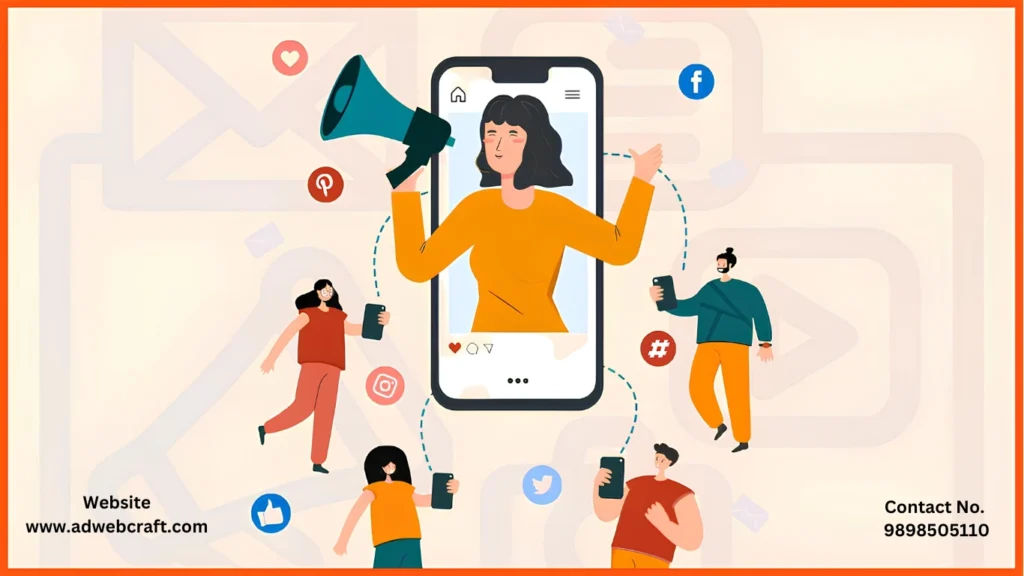Have we turned from Blog writers to Myth busters ? Are we now becoming “Messiah” for this digital world ? It would be great to be though . Jokes apart.
In the ever-evolving landscape of social media and digital marketing, businesses continually seek innovative strategies to connect with their target audiences. One such strategy that has gained significant traction is influencer marketing. But the pressing question remains: Is influencer marketing way of money or waste of money.? For that do we actually know , what is influencer marketing and how it works ?
Understanding Influencer Marketing
Influencer marketing involves collaborating with individuals who have a substantial and engaged following on social media platforms. These influencers can sway their audience’s purchasing decisions due to their perceived authority, knowledge, or relationship with their followers (if organic ones). This new species have different types in them . It is also called a part of Digital Marketing.
Types of Influencers: Nano, Micro, Macro, and Mega
Influencers are typically categorized based on their follower count:
- Nano-Influencers: 1,000 to 10,000 followers , Gen-Z college going students , newly initiated people , etc.
- Micro-Influencers: 10,000 to 100,000 followers , Some average youtubers , someone who has grown from nano , etc.
- Macro-Influencers: 100,000 to 1 million followers , Can be your celebrities , grown from macro, etc.
- Mega-Influencers: Over 1 million followers , Good well known celebrities , sportsperson , etc.
Each category offers distinct advantages. For instance, nano and micro-influencers often boast higher engagement rates and foster more intimate community relationships, while macro and mega-influencers provide extensive reach.
Platforms Dominating Influencer Marketing
Several platforms have become hotspots for influencer marketing:
- Instagram: Renowned for its visual content, it’s a preferred platform for lifestyle, fashion, and beauty influencers.
- YouTube: Ideal for long-form content, tutorials, and in-depth reviews.
- TikTok: Gaining popularity for short, engaging videos, especially among younger demographics.
- Facebook: Offers a broad user base and diverse content formats.
- X (formerly known as twitter): Effective for concise updates and engaging in trending conversations.
The Rise of Influencer Marketing in Digital Strategies

The influencer marketing industry has witnessed exponential growth. In 2024, the global influencer market reached $24 billion, tripling in size since 2019. In the digital age, influencer marketing has become a cornerstone of modern advertising strategies. This approach leverages the reach and credibility of social media personalities to connect brands with targeted audiences. Unlike traditional ads, influencer marketing is inherently more personal, as influencers share authentic and relatable content that resonates with their followers. With platforms like Instagram, TikTok, and YouTube offering direct access to millions of engaged users, brands can tap into niche communities and create highly targeted campaigns that drive conversions and brand loyalty.
The popularity of influencer marketing lies in its ability to build trust and foster meaningful connections between brands and consumers. Influencers act as intermediaries, blending storytelling with subtle brand promotion, which feels less intrusive than conventional advertising. Additionally, data analytics tools have made it easier to measure engagement and ROI, ensuring campaigns are both impactful and cost-effective. As businesses increasingly prioritize authenticity and consumer engagement, influencer marketing continues to grow as a vital component of digital strategies worldwide. Brands are allocating substantial portions of their marketing budgets to influencer collaborations. Notably, some brands dedicate 20-30% of their marketing budgets to influencer partnerships, recognizing the potential for enhanced brand awareness and consumer trust.
Case Studies of Successful Campaigns
Several brands have reaped significant benefits from influencer marketing:
- Daniel Wellington: Leveraged micro-influencers to promote their watches, resulting in a substantial increase in sales and brand recognition. Click to know more.
- Glossier: Built a beauty empire by engaging everyday consumers and influencers to share authentic product reviews and experiences. Click to know more.
- Fable & Mane: Invested in nano and micro-influencers, leading to heightened engagement and ROI. Click to know more.
Evaluating the Effectiveness of Influencer Marketing.
Metrics for Success: Engagement, Reach, and ROI
To assess the success of influencer marketing campaigns, brands often analyze Engagement, Reach, Return on Investment . We understand these terms as :
- Engagement: Likes, comments, shares, and saves indicating audience interaction.
- Reach: The total number of unique users who view the content.
- Return on Investment (ROI): Revenue generated compared to the campaign’s cost.
Studies suggest that brands earn an average of $6.50 for every $1 spent on influencer marketing, highlighting its potential profitability.
Why Influencer Marketing is better than Traditional Advertising ?
Influencer marketing offers distinct advantages over traditional advertising:
- Faster adaptability to trends : It’s difficult switching to some new trends according to market in traditional marketing as it needs funds as well as more efforts , influencer marketing will be simpler , just by changing the concept of content by influencer .
- Authenticity: Influencers provide genuine endorsements, fostering trust.
- Measurable results : One can easily measure the sales and results from the money they invested into an influencer.
- Targeted Reach: Ability to connect with niche audiences.
- Cost-Effectiveness: Often more affordable than traditional ad campaigns.
- Global Reach : Influencer marketing transcends geographic boundaries , and one can reach to influencers all over the world for expected results.
However, challenges such as fake followers and engagement fraud can undermine these benefits.
Challenges and Pitfalls in Influencer Marketing
As we know that everything comes with it’s positives and pitfalls , so for influencer marketing , pitfalls are :
- Fake Followers and Engagement Fraud : People purchase fake followers to enhance the visibility of their account , this can catfish the investor .
- Mismatched Partnerships and Brand Misalignment : Not all humans have same mindset and though process , that creates a wall between the partners in this marketing scheme . Many times , influencers try to show case their power by forgetting that investors can finish them within a span of time .
- Legal and Ethical Considerations : Navigating legal and ethical aspects is vital , influencer shouldn’t be involved and doing any illegal and unethical things.
- Difficulty with long-term relationships : Alike, traditional marketing here we don’t much know the influencer so it’s hard build a good relationship with which people might change and turn their ways from investor if someone else pays them better .
- Unpredictable results : Despite planning correctly and safely , we might and might not get the results that we expected and wanted to achieve .
- High cost of collaboration : Influencers with large followings, especially macro and mega-influencers, can demand high fees for collaborations.
After noticing such loopholes , are you also feeling the way Walter White from Breaking Bad felt in the beginning of show “How should I make more money.?” If yes , well we got you covered , at least in this field.
How to Maximize ROI in Influencer Marketing ?

To enhance ROI:
- Set Clear Objectives: Define goals such as brand awareness, engagement, or sales.
- Select Appropriate Influencers: Choose influencers whose audience aligns with the target market.
- Foster Long-Term Partnerships: Building ongoing relationships can lead to more authentic and effective promotions.
- Try to go for genuine influencers : People who actually have worked hard and are spreading some positive content and message .
- Payment schemes : Try to crack a deal for payment as according and with respect to the results you get .
- Authenticity and Transparency : Authenticity is a cornerstone of successful influencer marketing campaigns. Influencers who genuinely believe in the product or service they are promoting can communicate its value more effectively
- Measuring and Analyzing Campaign Performance :To ensure success, brands should continually measure the performance of influencer marketing campaigns.
- Key performance indicators (KPIs) such as engagement rates, click-through rates, conversions, etc.
Future Trends In Influencer Marketing.
The influencer marketing landscape is constantly evolving, with emerging trends shaping its future.
- Impact of Artificial Intelligence and Automation : AI-powered tools simplify influencer selection, campaign management, and performance analysis.
- Rise of Virtual Influencers : Virtual influencers, computer-generated personas, are gaining popularity for their unique appeal and ability to deliver consistent messaging without human unpredictability.
- Shifts in Platform Popularity and User Behavior : As platforms like TikTok and emerging social media channels continue to grow, brands must adapt their strategies to align with where their target audience spends time. Similarly, shifts in user behavior, such as the increasing preference for short-form video content, require innovative approaches to engage audiences effectively.
So , what does adwebcraft thinks you should do.?
Influencer marketing presents both opportunities and challenges. While its effectiveness depends on careful planning, thoughtful execution, and alignment with brand goals, it has the potential to deliver exceptional returns when done correctly. People are earning and getting good visibility with which many people are not able to earn in-fact , they had to bare loss of funds and time.
Ultimately, the decision to invest in influencer marketing should be informed by a thorough understanding of its potential, pitfalls, and alignment with broader marketing objectives. By approaching it with a strategic mindset, brands can navigate this powerful yet complex channel to achieve meaningful results. It is not as complicated as rocket science with which it is also not as easy as writing a blog ( just kidding ) , all the factors mentioned in this blog will help you decide , on our behalf we conclude that it definitely is a way of money if executed smartly and with strategic planning .



